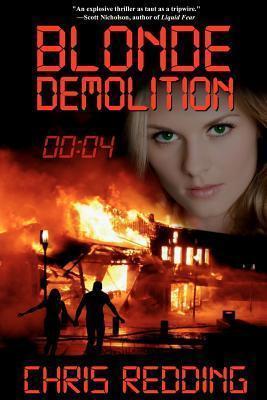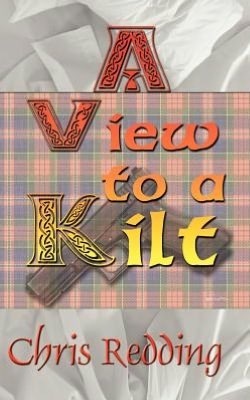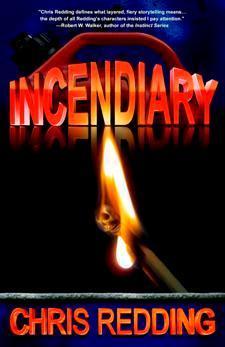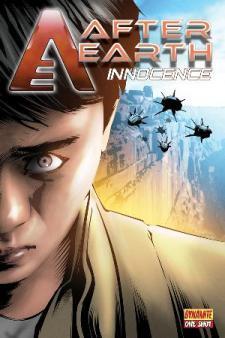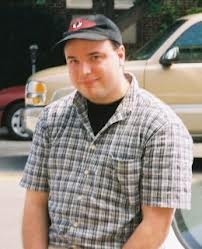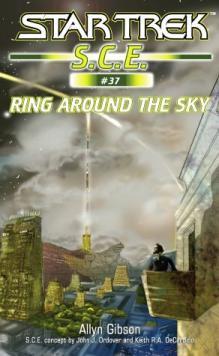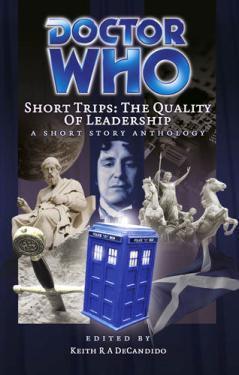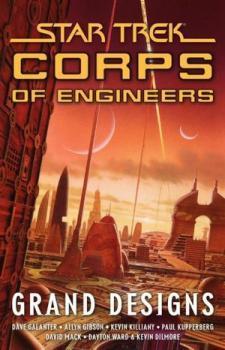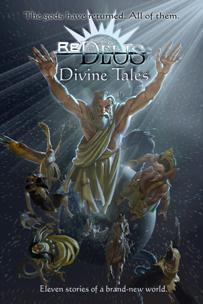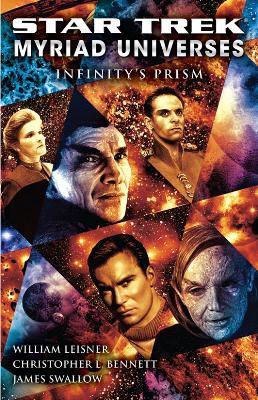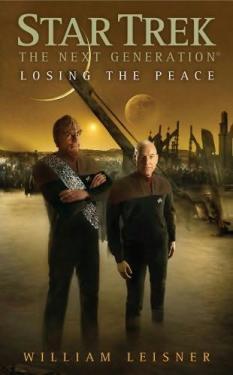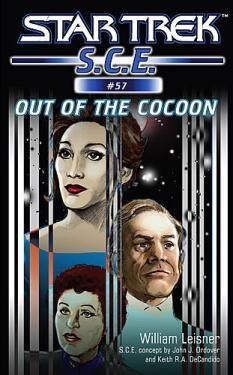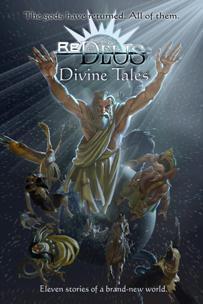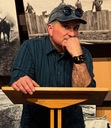Phil Giunta's Blog, page 100
October 7, 2012
About This Writing Stuff...
All that and more...enjoy!
Support Your Local Bookstore by Steven H. Wilson
Self-Publishing: Second Class No More? by Terri Giuliano Long
Ebooks in Libraries: They Still Don't Get It by Joe Konrath
What I Learned from Self-Publishing by Cherie Marks
Structure Part 4- Testing Your Idea - Is it Strong Enough to Make an Interesting Novel? by Kristen Lamb
Why Writers Disappear by Kristine Kathryn Rusch
Things I Learned While Drafting by Veronica Sicoe
How Party Planning is Like World Building by Diana Peterfreund
October 2, 2012
Author Interview: Chris Redding
Recently, Chris Redding re-released her thriller novel, Incendiary, with a new publisher. Back in May 2010, I answered a post from Chris on the Writers Coffehouse Yahoo group inviting authors to provide a blurb about their books for one of her weekly blog posts. Chris was kind enough to host me on her blog and I am happy to be able to return the favor!
First, tell us where we can find you online.
http://chrisredddingauthor.blogspot.com
www.facebook.com/chrisreddingauthor
www.twitter.com/chrisredding
At what age did you realize your talent for writing and storytelling? What was the first story you ever wrote, published or not?
I was ten. The assignment was to write a short story. I wrote about an old lady who had a bunch of cats. I received an “A” and was allowed to read it in front of the class. Before I read I was the geeky, four-eyed know it all. The class had a new respect for me after I read my story. I don’t remember the name of it.
My current novels (both published and forthcoming) are both in the paranormal genre. As such, I was curious as to what inspired one of your early novels,
Corpse Whisperer
(Enspiren Press, October 2007 now self-published).
There used to be a show called Tru Calling. Tru worked in the morgue and when she touched certain people, she would rewind back in time to prevent their deaths. I took it one step further to only murder victims and made my heroine a paramedic.
Two of your novels, Blonde Demolition (Imajin Books, November 2011) and The Drinking Game (CreateSpace, June 2011) deal with characters in law enforcement (cops, the FBI and Homeland Security, for example). What attracts you to crime/mystery/action adventure as a backdrop for romance?
I love men in uniform? I have worked in EMS in some form for almost 20 years. The last few only tangentially, but it has brought me in contact with law enforcement. I am fascinated by their mentality. Also, when I was a kid I read 3 grades ahead of the one I was in so at a young age I was reading adult novels. Agatha Christie was something my mom felt comfortable letting me read so I kind of grew up on crime novels.
Gotta love a title like
A View to a Kilt
(Echelon Press, November 2011)! Can you give us a blurb on the story?
She’s an interior decorator with a secret. He’s a former FBI agent who needs to know her secret to solve his wife’s murder. Mayhem ensues!
You’ve recently re-released Incendiary (Imajin Press, September 2012), a crime drama dealing with arson. I recently had a long discussion with a few other authors about the value of a cover that really ‘pops’. What was the catalyst behind your decision to change the cover on Incendiary?
That’s easy. I changed publishers.
What can readers expect next from you?
That I will try many new things. I have the attention span of –oh look, a squirrel- lol. I don’t like to be bored. Right now I am dabbling in romantic comedy. I seem to have a sense of humor in my writing (as in life) so I am going with it. And the romantic comedies will involve dogs.
What does Chris Redding do when she isn’t writing?
I wish I had some witty answer, but I spend so much time on my writing career that I don’t have a fascinating hobby. I do like to cook and am thinking about writing a cook book. I also cart my younger son to and from cross country meets and 4-H rabbit shows. I used to cross stitch.
Tea with Heroic Park author, Lance Woods!
Tea with Lance Woods

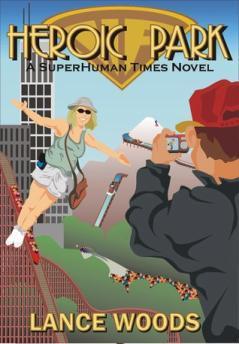
September 29, 2012
About This Writing Stuff...
This week, Fred Rosen enlightens us on selling TV and film rights for our books and Kristen Lamb further educates us on structure. Jami Gold is concerned about the damage caused by fake reviews while Konrath takes the opposite approach. Kristine Kathryn Rusch encourages to stop thinking small and adopt a long term perspective for our writing careers. The ALA is at wits end with traditional publishing over book lending while James Scott Bell talks book discovery.
Bob Greenberger salutes Star Trek: The Next Generation and talks up the After Earth media tie-in novels and comics leading up to the film to be released in 2013 starring and co-produced by Will Smith. Earlier this year, Bob--along with NYT bestselling authors Peter David and Michael Jan Friedman--met with Will Smith in person to discuss the media tie-in projects. Exciting stuff!
And more....enjoy!
Selling Your Book's Movie and TV Rights - What You Need to Know by Fred Rosen
Structure Part 2 - Plot Problems and Part 3 - Introducing the Opposition by Kristen Lamb
Watching the Numbers by Kristine Kathryn Rusch
How Fake Reviews Hurt Everyone by Jami Gold
Konrath Posts Fake Amazon Reviews by Joe Konrath
How Will Your Book Get Discovered in the Rolling Sea of Digital Publishing? by James Scott Bell
OverDrive Now Available on Nook via Digital Book Wire
Are Publishers Making a Killing on eBooks? - Part 1 by Richard Curtis
Librarian Patience Has Run Out on E-Book Lending Issues, ALA Says by Jeremy Greenfield
After Earth Novels now Available for Pre-Order by Bob Greenberger
Saluting Star Trek: The Next Generation by Bob Greenberger
September 22, 2012
Sci-Fi Day-Olde Towne Books and Brew - Mechanicsburg, PA
My financee and I arrived at about 1PM and I was scheduled to speak an hour later in the Tea Room at the back of the shop. Lawrence had arrived before us and was hanging out in one of the restaurant style booths in front of the shop. Olde Towne Books and Brew is part used book store, part ice cream and coffee shop that resides in what used to be a pharmacy well over 100 years old. Outside the shop, a local Klingon fan club was constructing their Klingon jail and the storefront was decorated with STARFLEET banners and signs.
My talk started at about 2:10 or so with a very attentive audience. After introducing myself and chatting briefly about writing in general and the changes in the publishing industry, I read a brief scene from Testing the Prisoner and another from ReDeus: Divine Tales . I had feared that I wouldn't be able to fill 45 minutes and it turned out that I ran over by about 5 minutes.
The authors' tables were set up in a slightly cramped area in the back of the shop outside of the Tea Room. By the time I left the Tea Room after my talk, both Michael and Darrell had arrived and set up their tables. Evon and I browsed the shop for a bit, and chatted with one young SF fan that also held a deep interest in the paranormal. I also spotted Beryl Washington, captain of the USS Sovereign, a Philadelphia area chapter of STARFLEET, and a few familiar faces from the convention scene.
We ended the day with dinner at the Gingerbread Man on Main Street. Evon and I sat with XO Jim Hutley and Keith Shikowitz, captain of the USS Abraham Lincoln, a New York chapter of STARFLEET. Good conversation and decent food, although the waitress screwed up all four of our orders in one fashion or another. :-)
On the way home, Evon and I stopped off at Bass Pro Shops at the Harrisburg Mall as I needed to pick up some fishing supplies.
Overall, it was a fun day. Nice to see familiar faces and meet new friends. Major Kudos and thanks to Doris Hutley of the USS Susquehannock for organizing the event along with Carl Dietrich, Jim Hutley, and everyone from the chapter.
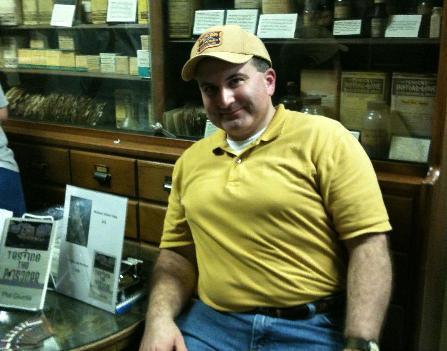
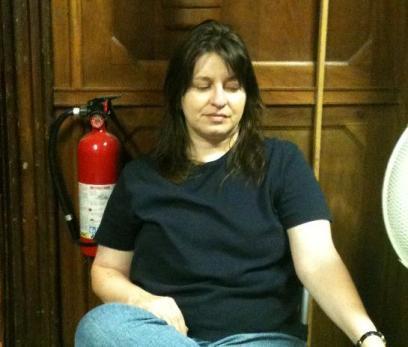 Above: Phil and Evon and Sci-Fi Day at Olde Towne Books and Brew.
Above: Phil and Evon and Sci-Fi Day at Olde Towne Books and Brew.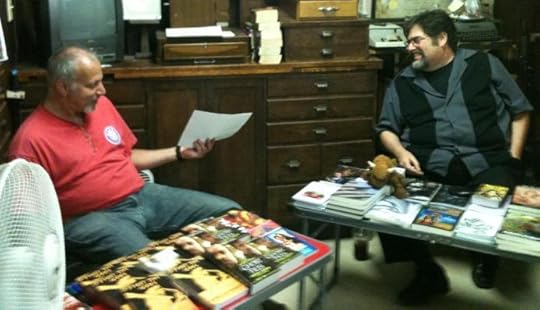 Above: Michael Jan Friedman (left) and Lawrence Schoen.
Above: Michael Jan Friedman (left) and Lawrence Schoen.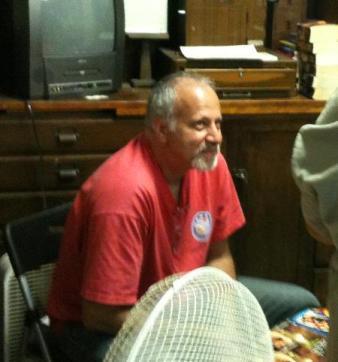
Michael talking with a fan who had just purchased a book or two (hence Mike's look of glee).
September 21, 2012
Author Interview: Allyn Gibson
What do you get when you cross a Star Trek fan with a Doctor Who fan with a Beatles fan with a baseball fan who also likes museums and hiking? You get fiction and media tie-in writer, Allyn Gibson. Allyn also writes for PREVIEWS, Diamond Comic Distributor's monthly catalog. Find out how Allyn's love of baseball found its way into his contribution to the anthology, ReDeus: Divine Tales...
First, tell us where we can find you online.
I'm very easy to find online. I have a blog at allyngibson.net that I've been maintaining for over ten years now. I have a LiveJournal account (tiggerallyn) that mirrors my blog. I'm also on Twitter (handle: allyngibson) and Facebook. I'm not on Tumblr yet, though I have set up an account (again, allyngibson).
I used to make a blog post every day, but in the last year I've gotten away from that for several reasons. After a decade, I sometimes wonder what more there is to say. Also, there doesn't seem to be a blog readership any more; the kind of personal blogging that was common five years ago (“Here's what I did today,” “Here's what I had for lunch,” that kind of thing) has all but vanished as people have moved that kind of content over to Twitter and Facebook.
This realization has prompted a rethink of what I'm trying to accomplish with my site, so I'm developing a new site that combines a professional “This is who I am, this is what I do, this is what I write” site with a journal-esque blog site. The site design I have now is almost there, but it's clunky because that's not what it was designed for. I have to decide what gets featured, I have to remember what goes where, I'm locked into some kludgey design choices, and content gets lost easily.
What I'm developing now automates the content flow. Blog-type content doesn't get lost, and I've made it much easier for my professional content to come to the fore. While I've done WordPress development in the past, what I'd doing now is beyond anything I've done before.
Longtime readers of my blog will know that I've said in the past that I'm “close to completion” on this redesign since last October, but because I've been pushing myself to learn more about WordPress, even though I've been using it for eight years now, I'll find new and better ways of accomplishing something which results in scrapping work I've done. In many ways, coding this site is like redrafting a novel; I know what I want to achieve, and I have to work out the best way to achieve those goals.
The last summit to climb is Responsive Design – making a site that functions well and looks good on mobile devices and tablets.
The new site probably won't launch until the new year. Migrating ten years and thousands of blog posts won't happen overnight. I'm also planning to launch a podcast with the site relaunch.
Before publishing Star Trek stories with Pocket Books, did you write any fan fiction in the Trek universe or otherwise?
My mom keeps a notebook that I had when I was in fourth grade. In that notebook, there's a story that's set in the world of Arthur C. Clarke's 2010. It would have been in the early 80s that I wrote this, and when I was nine and ten years-old, I wanted the story that led us from the world as it was to the world that was Clarke's. The writings involved Heywood Floyd, and it was illustrated with drawings of space shuttles in orbit working on building the Discovery. That notebook, and a Sherlock Holmes story called “Murder at the Metropolitan Club,” would have been among my earliest stories – and they're both clearly fanfic.
I didn't write much in the way of Star Trek fan fiction as a young writer. In high school, the fan fiction I wrote was set in the world of Isaac Asimov's Robots/Foundation universe. There were two ideas I wanted to explore in these stories. First, how were the Spacer worlds settled and why did they rebel against Earth? Second, were there ever any robots built without the Three Laws. The main character in these stories was a humaniform robot named R.J. Washington who was a secret agent for Earth during the Spacer rebellion. They were inspired as much by the Robot City novels that were being published at the time as they were by Asimov's original work.
I dabbled with Star Trek fan fiction occasionally. The one that stands out was a story called “Foundation and Federation” that brought Data and R. Daneel Olivaw together because I thought that would be cool. In college I wrote spec scripts for Star Trek: Deep Space Nine and Star Trek: Voyager (one of each) and sent them off to the production offices. When the Strange New Worlds contest started, I began submitting Star Trek stories to that, but none were ever bought. To be frank, none of those stories were any good, though I did pilfer some of the ideas from one of the Strange New Worlds stories for my Star Trek: SCE novella, Ring Around the Sky. There were good ideas in some of these stories – comets covered with Dyson trees, the return of the Moriarty hologram as a computer virus, doomsday weapons set in motion centuries earlier when interstellar wars were conducted at sublight speeds – but the execution was poor.
How did you come to write for the Doctor Who anthology, Short Trips: The Quality of Leadership (Big Finish, May 2008)? Can you give us fellow Who fans a blurb about your story, “The Spindle of Necessity”?
I received an e-mail from Keith DeCandido one evening. He was putting together a Doctor Who anthology for Big Finish Productions, and he wanted to know if I wanted to pitch a story for it. The anthology was going to be about the Doctor's encounters with leaders, and I wrote back and said I'd love to be a part of it. I wrote out a couple of ideas that night, but the idea that I pitched to Keith came to me at about 4 o'clock the next morning. It quite literally woke me from a dead sleep, and I jotted down the ideas that roused me before I lost them. A few hours later, after the alarm went off, I did some rudimentary Wikipedia research to see if the idea would work, I saw that it did, and I sent my pitch off to Keith.
In “The Spindle of Necessity,” the sixth Doctor (he of the coat of many colors and the abrasive personality) meets the Greek philosopher Plato. The Doctor is running for his life – he's been put on trial by the Time Lords and he's seen a dark vision of his future. Plato is running from Athens – his teacher Socrates has been executed, and he's searching for some meaning to life. They meet in a bazaar in Egypt, and Plato tells the Doctor of his mad quest to find the Spindle of Necessity – the axis on which the world turns, which one can ascend to reach the heavens and meet the gods. Plato believes the Earth is the center of the universe, that the sun and the stars revolve around it. The Doctor knows this is madness, and together they embark on a very strange journey. It may just be that Plato – and not the Doctor – is right.
And it's written like a lost Socratic dialogue.
It's a very strange story, if you can't tell from that description. It drove me almost around the bend while writing it. I had a very specific vision for the story, with certain beats I wanted to hit, a gentle, light-hearted sort of thing like Fritz Leiber's “Lean Times in Lankhmar,” but I couldn't make that vision of the story work. Writing it as a dialogue was a last resort, and I tried it, honestly, because I had the deadline staring me in the face. I thought it was such a crazy idea that Keith would find the form of the story unacceptable and he'd give me a month's extension to make the story work. The dialogue, all 12,000 words, was written in two days. Keith loved it. He had me cut two thousand words from it, but otherwise it was fine. The lesson? Sometimes, you really should listen to the crazy ideas in your head. That crazy voice has good instincts.
I was really honored when it was chosen for reprint in Big Finish's “Best Of” anthology, Re:Collections.
You and I both have stories in the anthology, ReDeus: Divine Tales (Crazy 8 Press, August 2012). What inspired your story, “The Ginger Kid”?
When Bob Greenberger approached me about pitching a story for ReDeus, the first thing I did was to say “Yes” even though I had absolutely no ideas at all. I read his pitch document, and I was intrigued. At work, the day that I received the pitch invitation, I kept a notepad on my desk and I jotted down ideas throughout the morning. The first idea I had, which was a pretty good idea, was wholly unsuited to my strengths as a writer, and I suggested to my friend and coworker Lance Woods that he could have the idea if he wanted to approach Bob about a story for ReDeus.
The second idea I had was an idea that Dave Galanter separately came to – in a world where the gods have returned, what happens to the atheists?
The third idea was this – what, exactly, makes a god? Is it their power? Is it the faith and devotion that people have toward them? Arthur C. Clarke's Third Law -- “Any sufficiently advanced technology is indistinguishable from magic” -- came to mind. I've heard it said that humans must seem like gods to our pets. It seemed to me, then, that just because the gods appeared god-like to humans, it didn't follow that they really were gods, that there might be “gods above the gods.” And if there were real gods, off stage and out of human perception, what would they be?
This led me to the Baseball Gods.
I wanted to explore this world from the perspective of the “man of the street.” And I wanted to examine what faith means in a world of incarnate gods. Somehow, a baseball story seemed like the right way to do it.
There were a few direct influences on my thinking. The big one was Ted Chiang's award-winning story, “Hell is the Absence of God.” In this story, the Old Testament god is very real and his angels are very present in the modern world, the afterlife of heaven and hell is visible, and the knowledge of the gods and the afterlife has a definite effect on human behavior. I also had W.P. Kinsella's “The Last Pennant Before Armageddon” in mind. In this story Kinsella, the writer of Field of Dreams, tells about how the Baseball Gods have decreed that the Chicago Cubs winning the pennant and returning to the World Series will usher in the End Times. The Cubs' manager is very aware of this fact, and at a pivotal moment he puts the fate of the world in the hands of his pitcher, knowing that if the Cubs win the missiles will fly. I was also inspired by the baseball writings of Ring Lardner, in particular his story story “My Roomy” about a ballplayer whose roommate on the road has some very strange behaviors. The other inspiration was Michael Bishop's novel Brittle Innings, a fascinating novel about a minor league season in Georgia during World War II – and the discovery that the team's star first baseman is the Frankenstein Monster. All of those sources went into the blender, and from the resulting soup emerged “The Ginger Kid.”
I had some trouble writing “The Ginger Kid,” and it came from an unexpected direction. I'm one of the godless – I came out as an atheist when I was sixteen, and for years before that my beliefs were shaky – and because I've been godless for so long I don't remember what it's like to have faith. Oddly enough, Peanuts came to my rescue, specifically It's the Great Pumpkin, Charlie Brown. It occurred to me that Linus' devotion to the Great Pumpkin was faith – a strange faith, but faith nonetheless. I put the DVD in, watched it twice, and said, “Okay, I get it.” The Ginger Kid's line in the story about his “sincerity” was a tip of the hat to It's the Great Pumpkin, specifically to Linus' speech about how the Great Pumpkin only visits the most sincere pumpkin patches on Halloween. And when I named the pantheon of Baseball Gods, it made sense to include Charlie Brown's hero, Joe Shlabotnik of Stumptown in the Green Grass League, among them.
Final thought (and final inspiration) on the story. “The Ginger Kid” is a real baseball nickname. It belonged to Buck Weaver, the third baseman for the Chicago White Sox in the 1910s. Weaver was implicated in the “Black Sox Scandal” -- several White Sox players conspired with gamblers to throw the 1919 World Series – and was banned from baseball for life. Weaver's only crime appears to be that he knew about the scheme. Otherwise, he was an innocent bystander, and because he did nothing to stop it he was banished from baseball. That story appealed to me, and I liked the idea of an innocent kid caught up in a larger drama of gods and miracles.
I’d be afraid to put you and my fiancée on a Beatles discussion panel. No one else would get a word in! In your opinion, what makes The Beatles’ music so enduring?
Oh, where to start!
No, seriously, I think the answer for the enduring appeal of the Beatles is very simple. It's not the nostalgia for the innocence of the sixties. It's not even that their music is part of the cultural DNA. It's the message of the music. The Beatles' songs, by and large, are about love, life, understanding, and happiness. Yes, they could do rip-roaring rock-n-roll, and they had their avant garde moments, but when you strip the Beatles down, their music is about living, loving, and being. Those are resonant messages for every one of us.
But I do think there's more to the Beatles than their music. Help! (the movie) may be a stoned-out mess, but A Hard Day's Night is an amazing and timeless film that I can watch again and again. Also, if you want to understand the cultural moment of the Beatles, A Hard Day's Night is essential in that it documents what Beatlemania was like in the moment without the retrospective perspective of any documentary on the phenomenon.
Let me make two book recommendations for people who are interested in the Beatles, their music, what they did, and what it meant. First, Tim Riley's Tell Me Why, which is an album-by-album analysis of the Beatles' music and some discussion of the post-Beatles careers of John, Paul, George, and Ringo. The latest edition, which came out about a decade ago, covers the Anthology reunion and corrects some textual errors in an afterword. Next, Ian MacDonald's Revolution in the Head, a song-by-song look at the Beatles' recording career, set in the context of an analysis of 60s culture. The third edition, which came out in 2005, is a complete revision of previous editions and includes material on the Live at the BBC and Anthology albums. Of the two books, Riley's is an easier read; it's written for a mainstream audience. MacDonald's book is, in my opinion, the better and more interesting book (MacDonald is a better writer than Riley, and his insights are more incisive), but it's also a little more difficult to read alongside the music; Riley looks at the (UK) albums in the configurations as they were released, while MacDonald looks at the songs in the order they were recorded, completely eschewing the album configurations. They have some vastly different opinions on the music and the Beatles themselves, and while I don't agree entirely with either man, I've found both books to be enjoyable and educational, deepening my understanding and appreciation of the Beatles' music over the years.
What can readers expect next from you?
That depends on the kind of work they're looking for.
I'm published every month. Since July 2007 I've been the writer of Diamond Comic Distributor's monthly catalog, PREVIEWS, and I write between 70 and 80 thousand words of sales and marketing copy for the catalog each month. The September catalog arrived in comic shops at the end of August, and (as I'm writing this) I'll be finishing up writing the October catalog within the coming week.
As for fiction, I'm currently working on a fantasy novel, but I have no timeframe for completion or destination once it's finished. This novel is actually related to the podcast that I plan on launching; the research for the novel's historical and mythical background led me to some interesting material that has been unjustly forgotten that I plan to explore in the podcast.
Also, if there's another ReDeus anthology, I brainstormed several ideas recently that I can pull out and pitch depending on what Bob Greenberger and Aaron Rosenberg are looking for.
What does Allyn Gibson do when he isn’t writing?
Sleep.
That sounds silly, but it's close to the truth. My day job is writing, and I write personally or freelance. I'm always writing. I might be at the keyboard. I might have a notepad. (A third of “The Ginger Kid” was written by hand.) I might be thinking about writing. Or I might be reading because of something I have to write. I'm never very far from words.
When I do take a break from the words, there are some things I like to do.
I love hiking. There's something very nice about disconnecting from the world and getting out into nature. There are some lovely areas near where I live. I don't totally disconnect from writing on these hikes, though; I often take a pocket notebook with me so I can jot down ideas that come to me. I also enjoy taking pictures of nature on these hikes. I used to post photo albums from these on Facebook, but I've realized that my friends probably don't need to see more of my nature photography.
I'm a museum hound. DC and its museums are an easy day trip. Baltimore has some decent museums as well. When I was younger, I didn't appreciate the art museums, but now that I'm older art museums really appeal to me.
Besides coding my own website, I do some freelance WordPress design work.
I'm thinking of buying an electric guitar. There's an electric guitar in the sixth floor conference room at the office, and I keep going into the office just to pick it up, hold it, and pluck the strings. I don't know how to play the guitar, so if I bought one I'd have to learn. There are things I need in life before I need a guitar, and I keep telling myself that. But I know me, and I know there will come a point where I'll pull the trigger.
I really should buy a new bike before an electric guitar, though.
About This Writing Stuff...
For every thing, there is a season...including publishing according to Dean Wesley Smith. For Kristine Kathryn Rusch, content is king...and NYT bestseller Peter David is Pulling Up Stakes!
How to Get 200,000 Page Views in a Year and a Half on a Shoestring Budget by ePublish a Book Blog
Amazon and Book Review Ownership by Shawn Lamb
The Value of Free: Writing for Non-Paying Markets by Chris F. Holm via Chuck Sambuchino
When Should a Writer Stop Marketing a Book? by Jody Hedlund
How to Write Proficiently About Things You Don't Know by Jody Hedlund
Anatomy of a Best-Selling Novel - Structure Part One by Kristen Lamb
Tighten Thy Subplots by Veronica Sicoe
Heroes and Villains by Sophie Masson
The Seasons of Publishing by Dean Wesley Smith
Content is King by Kristine Kathryn Rusch
Peter David is Pulling Up Stakes on Crazy 8 Press
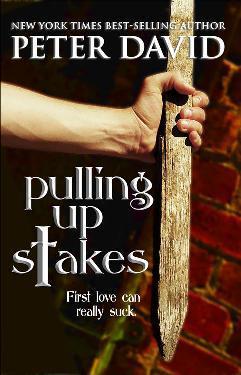
Bookmarks!!

September 18, 2012
New Release! Chris Redding's "Incendiary"
Congratulations to Chris Redding on the release of her fifth novel, Incendiary, currently available as a Kindle book with paperback to debut today, September 25!
What if your past comes back to haunt you?
Chelsea James, captain of the Biggin Hill First Aid Squad, has had ten years to mend a broken heart and forget about the man who'd left her hurt and bewildered. Ten years to get her life on track. But fate has other plans.
Fire Inspector Jake Campbell, back in town after a decade, investigates a string of arsons, only to discover they are connected to the same arsons he'd been accused of long ago. Now his past has come back to haunt him, and Chelsea is part of that past.
Together, Chelsea and Jake must join forces to defeat their mutual enemy. Only then can they hope to rekindle the flames of passion. But before they can do that, Chelsea must learn to trust again. Their lives could depend on it.
And check out Chris Redding's previous titles below. Click each image for more information.
September 14, 2012
Author Interview: William Leisner
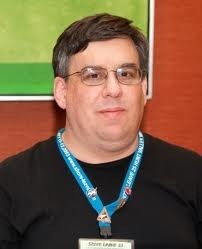
First, tell us where we can find you online.
You can find me on Facebook, Twitter (@BLeisner), and occasionally on LiveJournal (bill-leisner.livejournal.com)
At what age did you realize your talent for writing and storytelling?
I had played around with making comic strips to entertain my younger siblings back when I was 7 or so. But I didn't really think seriously about writing until my freshman year at Ithaca College. That year, the campus television station was starting up an anthology-style series of original productions and looking for short scripts to produce. I decided to give that a try, so I went to the campus library, checked out a book on script format, and wrote. To my surprise, mine was one of three scripts selected, and I haven't looked back since.
Before publishing Star Trek stories and novels with Pocket Books, did you write any fan fiction in the Trek universe or otherwise?
I actually first dipped my toe into Star Trek fiction by writing and submitting a spec script for Deep Space Nine, back when the producers were accepting unagented submissions. That script got me invited to pitch stories to DS9 and Voyager, but except for one small nibble, I never quite made the cut. I got into fan fiction shortly after, as I became more involved in the online fan community on AOL, publishing in a few print zines and online venues. That served as good practice for when Pocket Books launched their Strange New Worlds writing contest, which is how I finally broke into professional publication.
You and I both have stories in the anthology, ReDeus: Divine Tales (Crazy 8 Press, August 2012). What inspired your story, “The Year Without a Santa Claus”?
In the series bible Bob Greenberger and Aaron Rosenberg sent out to the anthology's invitees, it specified that the ancient gods first returned on opening day of the London Summer Olympics. But it also tied the end of the Mayan calendar, which occurs some five months later, into this world-altering event. So I started wondering what happens at the Winter Solstice that could even come close to the significance of The Return. And with the Solstice falling days before Christmas season, during "the season of miracles," it all came together from there.
What can readers expect next from you?
I'm currently at work on a new Star Trek novel, which is due out next summer (no final title as yet). I also have an original novel in the works -- a historical fantasy set on the western frontier in 1850 -- which I hope to start shopping to publishers in the early part of 2013.
What does William Leisner do when he isn’t writing?
I have a regular office job that takes up most of my waking non-writing hours. Outside of that, I enjoy reading and browsing bookstores, and spending time with friends.


